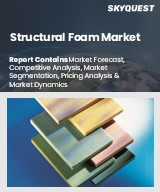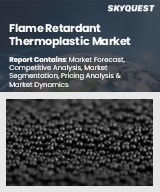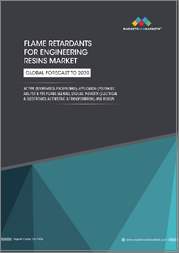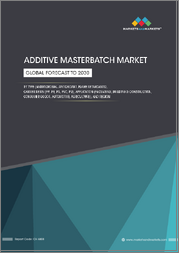
|
시장보고서
상품코드
1479870
세계의 난연성 화학제품 시장 - 예측(2024-2029년)Global Flame Retardant Chemicals Market - Forecasts from 2024 to 2029 |
||||||
세계의 난연성 화학제품 시장은 2022년에는 100억 7,100만 달러로 평가되었고, CAGR 5.58%로 성장할 전망이며, 2029년에는 147억 3,400만 달러 규모에 이를 것으로 예측됩니다.
난연성 화학물질로 알려진 화학제품은 화재의 확대를 방지하거나 지연시키고, 연소의 위험을 줄이고, 화재의 안전성을 높이기 위해 재료에 적용됩니다. 물질을 식히고, 장벽을 만들고, 연소로 이어지는 화학적 상호 작용을 차단하는 등 다양한 방법으로 연소 과정을 차단합니다.
난연성 화학제품으로서 자주 사용되는 화학물질에는 인계, 질소계 화합물, 할로겐계 화합물(브롬계, 염소계 난연성 화학제품 등), 광물계 첨가제(수산화마그네슘, 수산화 알루미늄 등) 등이 있습니다.
시장 동향 :
난연성 화학제품의 주요 최종 사용자 시장은 건축, 건설, 전기, 전자, 운송, 섬유, 가구입니다. 건설활동의 활성화와 전기 및 전자제품 수요 증가에 의해 업계 전체에서 난연성 화학제품 수요가 증가하고 있습니다. 환경과 건강에 대한 의식이 높아지고 친환경 난연성 화학물질에 대한 의식이 높아짐에 따라 난연성 화학물질 수요를 끌어올려 시장 전체의 성장을 가속할 것으로 예상됩니다.
게다가 바이오의 난연성 화학제품의 사용이 증가하고 있기 때문에 친환경 난연성 화학제품을 도입함으로써 제조업체가 이익률을 높이는 성장 기회가 더욱 넓어질 것으로 보입니다. 가장 널리 사용되는 난연성 화학물질은 폴리브롬화 디페닐 에테르, 테트라브로모비스페놀 A(TBBPA), 유기 인계 난연성 화학물질입니다. 또한, 원재료 부족과 건강과 환경에 대한 유해한 영향이 향후 수년간 시장 성장을 방해할 것으로 예상됩니다.
시장 성장 촉진요인 :
- 건설 업계에서의 난연성 화학제품의 용도 확대가 시장 성장의 원동력이 될 것으로 예상됩니다.
시장 성장을 가속하는 주된 이유 중 하나는 최종 사용자 산업, 특히 건축 및 건설 업계 수요가 지속적으로 증가하고 있다는 것입니다. 엄격한 화재 안전 규제로 인해 건축 분야에서는 난연성 화학제품에 대한 수요가 높습니다. 주택과 상업용 건물에서 난연성 화학은 주로 구조 단열재에 사용됩니다.
많은 주택과 상업시설에서는 에너지 효율이 높고 광열비가 저렴하기 때문에 단열재가 사용되고 있습니다. 전 세계적으로 다양한 방화 기준과 관련된 규칙과 규정이 점점 더 엄격 해지고 있으며 시장 성장을 더욱 촉진할 것으로 예상됩니다. 예를 들어, 유럽 국가에서는 건축 목적으로 사용되는 모든 재료(난연성 화학물질 포함)는 EN13501에 따라 화재 요건에 대한 특정 사양을 충족해야 합니다. 미국에서는 모든 재료가 ASTM E 84에 따라 시험되어야 합니다.
인도 정부는 국민 주택 은행 아래에 주택 기금을 설립했습니다. 주택 및 주택 분야에 대한 지속적인 지출은 시장 성장을 가속할 것으로 예상됩니다. 중국은 주요 경제국 중 하나이며 향후 몇 년동안 시장을 견인할 것으로 예상됩니다. 국가발전개혁위원회에 의하면, 이 나라에서는 최근 수로, 고속도로에서 주택 프로젝트까지 주요 프로젝트의 건설이 급증하고 있습니다.
- 화재 위험에 대한 우려 증가는 난연성 화학 시장의 성장에 영향을 줄 수 있습니다.
난연성 화학물질 시장은 화재 위험에 대한 우려 증가에 의해 큰 영향을 받고 있으며, 이는 여러 산업에서 상당한 시장 개발을 추진하고 있습니다. 주택, 상업시설, 공업시설에서의 화재 사고 건수가 증가함에 따라, 화재 안전 대책의 필요성이 부각되고 있습니다. 세계 정부와 규제 기관은 전자 기기, 섬유 제품, 자동차 부품, 건축자재 등 다양한 제품에 난연성 화학제품의 사용을 의무화하는 엄격한 건축 규칙 및 법률을 시행했습니다.
난연성 화학물질은 화재 사고의 위험을 줄이기 위해 제조업체와 소비자가 난연성 제품을 우선적으로 사용하게 되었기 때문에 수요가 증가하고 있습니다. 난연성 화학제품 시장은 화재 위험에 대한 우려가 증가함에 따라 급성장하고 있습니다. 이러한 성장은 규제 대응, 기술적 개선, 지속가능성에 대한 노력, 광범위한 분야에서의 용도 확대 등 많은 요인들에 의해 강화되고 있습니다.
억제요인 :
난연성 화학제품 시장은 주목할만 한 성장 촉진요인이 있더라도 성장을 방해할 수 있는 많은 제약에 노출되어 있습니다. 기존의 난연성 화학제품이 환경과 인체에 미치는 영향에 대한 관심이 높아지고 있는 것이 주요 장애물 중 하나입니다. 독성, 난분해성, 생물 축적성에 대한 우려로 인해 규제기관이 특정 난연성 화학제품의 사용에 제한을 두어 환경 친화적인 대체품의 인기가 높아지고 있습니다.
또한 시장 진출기업은 혁신적인 난연성 화학 기술을 개발하고 전개하는 비용과 규제 요건을 준수하는 어려움으로 인해 재무 및 경영상의 어려움에 직면해 있습니다. 전반적으로 난연성 화학제품 시장이 세계적으로 성장하고 있지만 장기적으로 업계가 발전하고 경쟁을 유지할 수 있는지 여부는 이러한 기술적, 재정적, 법적 및 환경적 제약 에 어떻게 대처할 수 있는지에 달려 있습니다.
북미는 주요 지역 시장이 될 것으로 예상됩니다.
북미의 난연성 화학 시장은 성장과 확대를 촉진하는 많은 요인들에 의해 견인되고 있습니다. 난연성 화학에 대한 요구는 정부 당국과 산업 표준화 단체에 의해 설정된 엄격한 화재 안전 규칙에 의해 초래됩니다. 이러한 규제는 건설, 자동차, 전자기기, 섬유 등 여러 산업에 존재합니다. 난연성 화학 시장은 지속적인 인프라 건설 및 리노베이션 프로젝트로 대표되는 이 지역의 강력한 건설 부문에 의해 지원되며, 내화재료 및 코팅에 대한 큰 요구를 창출하고 있습니다.
또한, 난연성 화학제품의 유효성, 환경 지속성, 최종 용도에의 적합성을 향상시키는 것을 목적으로 한, 난연성 화학제품의 기술 개척이나 배합 개선도 시장 확대의 원동력이 되고 있습니다. 게다가 이 지역의 견조한 전자 및 전기기기 제조 부문과 자동차의 안전기준을 높이기 위해 자동차산업에서 난연재료의 사용이 확대되고 있는 것도 북미시장의 전체적인 성장궤도를 지원하고 있습니다.
주요 발전 :
- 2023년 10월 지속가능성에 중점을 둔 특수화학 사업을 전개하는 클라리언트는 혜주시 대아만에 무할로겐 난연성 화학제품의 최신예 생산시설을 정식으로 개설하여 중국 전략의 새로운 중요한 이정표였습니다.
- 2022년 7월 엄격한 화재 안전 규정을 충족하고 특정 플라스틱 화합물의 지속가능성과 성능을 향상시키는 완벽한 솔루션을 고객에게 제공하기 위해 BASF와 THOR GmbH는 비할로겐 난연성 화학제품 첨가약에 관한 전문 지식을 결집했습니다.
목차
제1장 서론
- 시장 개요
- 시장의 정의
- 조사 범위
- 시장 세분화
- 통화
- 전제조건
- 기준년 및 예측년의 타임라인
- 이해 관계자의 주요 이점
제2장 조사 방법
- 조사 디자인
- 조사 과정
제3장 주요 요약
- 주요 조사 결과
- 애널리스트 보기
제4장 시장 역학
- 시장 성장 촉진요인
- 시장 성장 억제요인
- Porter's Five Forces 분석
- 업계 밸류체인 분석
- 애널리스트 보기
제5장 세계의 난연성 화학제품 시장 : 유형별
- 서문
- 할로겐
- 시장 동향 및 기회
- 성장 전망
- 지리적 이익성
- 인광물질
- 시장 동향 및 기회
- 성장 전망
- 지리적 이익성
- 산화안티몬
- 시장 동향 및 기회
- 성장 전망
- 지리적 이익성
- 기타
- 시장 동향 및 기회
- 성장 전망
- 지리적 이익성
제6장 세계의 난연성 화학제품 시장 : 최종 사용자 업계별
- 서문
- 섬유
- 시장 동향 및 기회
- 성장 전망
- 지리적 이익성
- 자동차
- 시장 동향 및 기회
- 성장 전망
- 지리적 이익성
- 건설
- 시장 동향 및 기회
- 성장 전망
- 지리적 이익성
- 전기 및 전자
- 시장 동향 및 기회
- 성장 전망
- 지리적 이익성
- 기타
- 시장 동향 및 기회
- 성장 전망
- 지리적 이익성
제7장 세계의 난연성 화학제품 시장 : 지역별
- 서문
- 북미
- 유형별
- 최종 사용자 업계별
- 국가별
- 남미
- 유형별
- 최종 사용자 업계별
- 국가별
- 유럽
- 유형별
- 최종 사용자 업계별
- 국가별
- 중동 및 아프리카
- 유형별
- 최종 사용자 업계별
- 국가별
- 아시아태평양
- 유형별
- 최종 사용자 업계별
- 국가별
제8장 경쟁 환경 및 분석
- 주요 기업 및 전략 분석
- 시장 점유율 분석
- 합병, 인수, 합의 및 협업
- 경쟁 대시보드
제9장 기업 프로파일
- Clariant Ltd.
- Albermarle Corporation
- Daihachi Chemical Industry Co., Ltd
- JM Huber Corporation
- Thor Industries
- Apexical, Inc.
- MPI Chemie BV
- DIC Corporation
- Lanxess
The global flame-retardant chemicals market is evaluated at US$10.071 billion for the year 2022 and is projected to grow at a CAGR of 5.58% to reach a market size of US$14.734 billion by the year 2029.
Chemicals known as flame retardants are applied to materials to prevent or delay the spread of fire, lowering the danger of combustion and enhancing fire safety. Through a variety of methods, including chilling the substance, creating a barrier, or blocking the chemical interactions that lead to the spread of fire, these substances stop the combustion process.
Chemicals that are often employed as flame retardants include phosphorus- and nitrogen-based compounds, halogenated compounds (such as brominated and chlorinated flame retardants), and mineral-based additives (such as magnesium hydroxide and aluminum hydroxide).
MARKET TRENDS:
The major end-user markets for flame retardant chemicals are building and construction, electrical and electronics, transportation, textiles, and furniture. Rising construction activities and growing demand for electrical and electronic products have increased the demand for flame-retardant chemicals across the industry. Growing awareness about the environment and health concerns and rising awareness about eco-friendly flame retardants are anticipated to drive the demand for flame retardant chemicals, which is expected to drive the overall market growth.
Furthermore, the growing use of bio-based flame retardants is further going to unlock growth opportunities for manufacturers to increase their profit margins by introducing environment-friendly flame retardant chemicals. The most widely used flame retardant chemicals are- polybrominated diphenyl ethers, tetrabromobisphenol A (TBBPA), and organophosphate flame retardants. Moreover, the shortage of raw materials and their hazardous impact on health and the environment are expected to hinder the growth of the market in the coming years.
MARKET DRIVERS:
- Increasing application of flame retardant chemicals in the construction industry is anticipated to drive the market's growth.
One of the primary reasons driving the market's growth is the continually increasing demand from the end-user industries, especially in building and construction. Owing to strict fire safety regulations, there is a high demand for flame-retardant chemicals in the construction sector. In residential and commercial buildings, flame retardants are mostly used in structural insulation.
Many residential, as well as commercial sectors, use insulators because of their higher energy efficiency and low utility costs. Increasingly strict rules and regulations related to the various fire standards around the world are anticipated to further drive market growth. For example, in European countries, all materials that are used for construction purposes, including flame retardant chemicals, must meet certain specifications for fire requirements according to EN 13501. In the United States, all the material has to be tested according to ASTM E 84.
The government of India has set up a fund for housing, under the National Housing Bank. The continuous spending in the housing and residential sector is expected to drive market growth. China is one of the major economies, which is expected to drive the market in the coming years. According to the National Development and Reform Commission, the construction of major projects in the country has surged in recent years, from waterways, and highways to residential projects.
- Rising concerns about fire hazards might impact global flame retardant chemicals market growth.
The flame retardant chemicals market is being greatly impacted by growing concerns about fire dangers, which is propelling considerable development in several industries. The need for fire safety precautions has come to light as the number of fire incidents in residential, commercial, and industrial settings has increased. Governments and regulatory agencies across the globe have enforced strict building rules and laws that require the use of flame-retardant chemicals in a variety of products, such as electronics, textiles, automobile parts, and building materials.
Flame retardant chemicals are in high demand as a result of manufacturers and consumers placing a higher priority on fire-resistant products to reduce the danger of fire mishaps. The flame retardant chemicals market is rising rapidly due to growing concerns about fire dangers. This growth is being fueled by many factors such as regulatory compliance, technical improvements, sustainability initiatives, and expanding uses across a wide range of sectors.
RESTRAINTS:
The flame retardant chemicals market is subject to many constraints that may impede its growth, even with the notable growth drivers. The increased focus on the effects of conventional flame retardant chemicals on the environment and human health is one of the main obstacles. Environmentally friendly alternatives are becoming increasingly popular as a result of regulatory agencies placing limitations on the use of certain flame retardants due to concerns about their toxicity, persistence, and bioaccumulation.
Furthermore, market participants face financial and operational difficulties due to the high expenses of creating and deploying innovative flame retardant technologies as well as the difficulty of complying with regulatory requirements. Overall, even though the flame retardant chemicals market is growing globally, the industry's ability to develop and remain competitive over the long run depends on how well these technological, financial, legal, and environmental constraints are addressed.
North America is anticipated to be the major regional market.
The flame retardant chemicals market in North America is driven by many factors that foster its growth and expansion. The need for flame retardant chemicals is driven by strict fire safety rules set by government authorities and industry standards organizations. These restrictions are present in several industries, including construction, automotive, electronics, and textiles. The flame retardant chemicals market is supported by the region's strong construction sector, which is typified by continuous infrastructure building and renovation projects and generates a sizable need for fire-resistant materials and coatings.
Market expansion is also driven by technological developments and formulation improvements in flame retardants, which aim to improve efficacy, environmental sustainability, and compatibility with end-use applications. In addition, the region's robust electronics and electrical equipment manufacturing sector and the growing use of flame retardant materials in the automotive industry to raise vehicle safety standards support the market's overall growth trajectory in North America.
Key Developments:
- In October 2023, Clariant, a specialty chemical business with a focus on sustainability, officially opened its new, state-of-the-art production facility for halogen-free flame retardants in Daya Bay, Huizhou, marking another significant milestone in its China Strategy.
- In October 2022, Leading inventive organization Italmatch Chemicals, which specializes in performance additive chemicals, began building a new flame retardant factory in China, where it already has three sites.
- In July 2022, To give clients a complete solution that fulfills strict fire safety regulations and improves the sustainability and performance of certain plastic compounds, BASF and THOR GmbH pooled their expertise in non-halogenated flame retardant additives.
Segmentation:
By Type
- Halogen
- Phosphor
- Antimony Oxide
- Others
By End-User Industry
- Textiles
- Automotive
- Construction
- Electrical and Electronics
- Others
By Geography
- North America
- USA
- Canada
- Mexico
- South America
- Brazil
- Argentina
- Others
- Europe
- United Kingdom
- Germany
- France
- Spain
- Others
- Middle East and Africa
- Saudi Arabia
- UAE
- Israel
- Others
- Asia Pacific
- China
- Japan
- India
- South Korea
- Taiwan
- Thailand
- Indonesia
- Others
TABLE OF CONTENTS
1. INTRODUCTION
- 1.1. Market Overview
- 1.2. Market Definition
- 1.3. Scope of the Study
- 1.4. Market Segmentation
- 1.5. Currency
- 1.6. Assumptions
- 1.7. Base, and Forecast Years Timeline
- 1.8. Key Benefits for the stakeholder
2. RESEARCH METHODOLOGY
- 2.1. Research Design
- 2.2. Research Processes
3. EXECUTIVE SUMMARY
- 3.1. Key Findings
- 3.2. Analyst View
4. MARKET DYNAMICS
- 4.1. Market Drivers
- 4.2. Market Restraints
- 4.3. Porter's Five Forces Analysis
- 4.3.1. Bargaining Power of Suppliers
- 4.3.2. Bargaining Power of Buyers
- 4.3.3. Threat of New Entrants
- 4.3.4. Threat of Substitutes
- 4.3.5. Competitive Rivalry in the Industry
- 4.4. Industry Value Chain Analysis
- 4.5. Analyst View
5. GLOBAL FLAME RETARDANT CHEMICALS MARKET, BY TYPE
- 5.1. Introduction
- 5.2. Halogen
- 5.2.1. Market Trends and Opportunities
- 5.2.2. Growth Prospects
- 5.2.3. Geographic Lucrativeness
- 5.3. Phosphor
- 5.3.1. Market Trends and Opportunities
- 5.3.2. Growth Prospects
- 5.3.3. Geographic Lucrativeness
- 5.4. Antimony Oxide
- 5.4.1. Market Trends and Opportunities
- 5.4.2. Growth Prospects
- 5.4.3. Geographic Lucrativeness
- 5.5. Others
- 5.5.1. Market Trends and Opportunities
- 5.5.2. Growth Prospects
- 5.5.3. Geographic Lucrativeness
6. GLOBAL FLAME RETARDANT CHEMICALS MARKET, BY END-USER INDUSTRY
- 6.1. Introduction
- 6.2. Textiles
- 6.2.1. Market Trends and Opportunities
- 6.2.2. Growth Prospects
- 6.2.3. Geographic Lucrativeness
- 6.3. Automotive
- 6.3.1. Market Trends and Opportunities
- 6.3.2. Growth Prospects
- 6.3.3. Geographic Lucrativeness
- 6.4. Construction
- 6.4.1. Market Trends and Opportunities
- 6.4.2. Growth Prospects
- 6.4.3. Geographic Lucrativeness
- 6.5. Electrical and Electronics
- 6.5.1. Market Trends and Opportunities
- 6.5.2. Growth Prospects
- 6.5.3. Geographic Lucrativeness
- 6.6. Others
- 6.6.1. Market Trends and Opportunities
- 6.6.2. Growth Prospects
- 6.6.3. Geographic Lucrativeness
7. GLOBAL FLAME RETARDANT CHEMICALS MARKET, BY GEOGRAPHY
- 7.1. Introduction
- 7.2. North America
- 7.2.1. By Type
- 7.2.2. By End-User Industry
- 7.2.3. By Country
- 7.2.3.1. USA
- 7.2.3.1.1. Market Trends and Opportunities
- 7.2.3.1.2. Growth Prospects
- 7.2.3.2. Canada
- 7.2.3.2.1. Market Trends and Opportunities
- 7.2.3.2.2. Growth Prospects
- 7.2.3.3. Mexico
- 7.2.3.3.1. Market Trends and Opportunities
- 7.2.3.3.2. Growth Prospects
- 7.2.3.1. USA
- 7.3. South America
- 7.3.1. By Type
- 7.3.2. By End-User Industry
- 7.3.3. By Country
- 7.3.3.1. Brazil
- 7.3.3.1.1. Market Trends and Opportunities
- 7.3.3.1.2. Growth Prospects
- 7.3.3.2. Argentina
- 7.3.3.2.1. Market Trends and Opportunities
- 7.3.3.2.2. Growth Prospects
- 7.3.3.3. Others
- 7.3.3.3.1. Market Trends and Opportunities
- 7.3.3.3.2. Growth Prospects
- 7.3.3.1. Brazil
- 7.4. Europe
- 7.4.1. By Type
- 7.4.2. By End-User Industry
- 7.4.3. By Country
- 7.4.3.1. United Kingdom
- 7.4.3.1.1. Market Trends and Opportunities
- 7.4.3.1.2. Growth Prospects
- 7.4.3.2. Germany
- 7.4.3.2.1. Market Trends and Opportunities
- 7.4.3.2.2. Growth Prospects
- 7.4.3.3. France
- 7.4.3.3.1. Market Trends and Opportunities
- 7.4.3.3.2. Growth Prospects
- 7.4.3.4. Spain
- 7.4.3.4.1. Market Trends and Opportunities
- 7.4.3.4.2. Growth Prospects
- 7.4.3.5. Others
- 7.4.3.5.1. Market Trends and Opportunities
- 7.4.3.5.2. Growth Prospects
- 7.4.3.1. United Kingdom
- 7.5. Middle East and Africa
- 7.5.1. By Type
- 7.5.2. By End-User Industry
- 7.5.3. By Country
- 7.5.3.1. Saudi Arabia
- 7.5.3.1.1. Market Trends and Opportunities
- 7.5.3.1.2. Growth Prospects
- 7.5.3.2. UAE
- 7.5.3.2.1. Market Trends and Opportunities
- 7.5.3.2.2. Growth Prospects
- 7.5.3.3. Israel
- 7.5.3.3.1. Market Trends and Opportunities
- 7.5.3.3.2. Growth Prospects
- 7.5.3.4. Others
- 7.5.3.4.1. Market Trends and Opportunities
- 7.5.3.4.2. Growth Prospects
- 7.5.3.1. Saudi Arabia
- 7.6. Asia Pacific
- 7.6.1. By Type
- 7.6.2. By End-User Industry
- 7.6.3. By Country
- 7.6.3.1. China
- 7.6.3.1.1. Market Trends and Opportunities
- 7.6.3.1.2. Growth Prospects
- 7.6.3.2. Japan
- 7.6.3.2.1. Market Trends and Opportunities
- 7.6.3.2.2. Growth Prospects
- 7.6.3.3. India
- 7.6.3.3.1. Market Trends and Opportunities
- 7.6.3.3.2. Growth Prospects
- 7.6.3.4. South Korea
- 7.6.3.4.1. Market Trends and Opportunities
- 7.6.3.4.2. Growth Prospects
- 7.6.3.5. Taiwan
- 7.6.3.5.1. Market Trends and Opportunities
- 7.6.3.5.2. Growth Prospects
- 7.6.3.6. Thailand
- 7.6.3.6.1. Market Trends and Opportunities
- 7.6.3.6.2. Growth Prospects
- 7.6.3.7. Indonesia
- 7.6.3.7.1. Market Trends and Opportunities
- 7.6.3.7.2. Growth Prospects
- 7.6.3.8. Others
- 7.6.3.8.1. Market Trends and Opportunities
- 7.6.3.8.2. Growth Prospects
- 7.6.3.1. China
8. COMPETITIVE ENVIRONMENT AND ANALYSIS
- 8.1. Major Players and Strategy Analysis
- 8.2. Market Share Analysis
- 8.3. Mergers, Acquisitions, Agreements, and Collaborations
- 8.4. Competitive Dashboard
9. COMPANY PROFILES
- 9.1. Clariant Ltd.
- 9.2. Albermarle Corporation
- 9.3. Daihachi Chemical Industry Co., Ltd
- 9.4. J.M Huber Corporation
- 9.5. Thor Industries
- 9.6. Apexical, Inc.
- 9.7. MPI Chemie B.V.
- 9.8. DIC Corporation
- 9.9. Lanxess



















